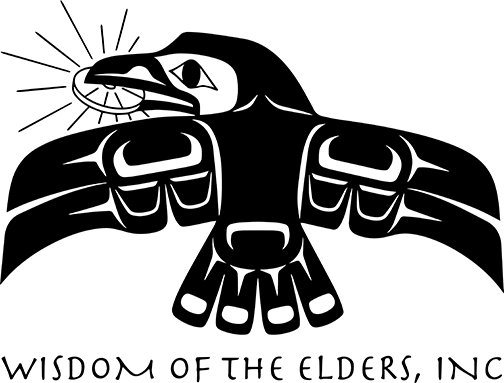Anne White Hat and Marie Randall
Arlie Neskahi:
For thousands of years, the use of plants for food, medicine, tools, clothing, homes and ceremony has been an important part of Native American family and community life. Lewis and Clark learned of some of these edible and medicinal plants from the tribes they met along the trail. In time, they came to rely on them for their survival. Judy Bluehorse Skelton speaks about traditional herbal knowledge as we visit with Teton herbalists, Marie Randall and her granddaughter, Annie White Hat.
Judy Bluehorse Skelton :
Native plants like Echinacea, Cedar, and Willow, along with hundreds of others, have been used by Native people for aches and pains, bites and wounds, coughs, fevers, infections and many other ailments. Different parts of the plants are used to make medicine, from roots, leaves and flowers to fruit, seeds and bark. They are gathered with respect and thankfulness each in their own season. Only what is needed is taken, always leaving many plants for future generations. This knowledge continues to be passed down from generation to generation. Grandmother, Marie Randall and her granddaughter, Annie White Hat of the Teton Sioux, continue their tradition of plant medicine and healing near the Rosebud reservation in the Black Hills. Marie says:
Marie Randall:
H an. Unci, um, iyasna, iyasna eh, wana pejuta, (okwi) okeyapiktehunka. My grandma goes out and she takes whoever is around as grandchildren. She gathers us and she prays with us before we go out. And when she finds the plant that she’s looking for. She has us children stand around that plant, and pray so that when she digs that plant out, and she puts back the dirt, there will be another plant coming up for the survival of the people that would be looking for the plant.”
Skelton:
Marie’s granddaughter, Annie, continues the tradition.
Anne White Hat:
We use um, Echinacea, the strongest Echinacea in the world grows here in our own back yard.
Skelton:
Like indigenous people throughout the world, Marie and Annie are concerned about the alarming loss of traditional gathering lands to encroaching development.
Randall:
Today, it saddens us to have those plants torn up, you know, with um, machines. It’s hard for us to go looking out for our plants. We can’t stop the man-made way of life, you know. The laws that we have to go by to go out and dig for whatever we need for our children’s survival. Grandma used to just walk out there with us out on the prairie.
White Hat:
We exercise our treaty rights to go out and harvest and to hunt. (laughs) Those are rights that we have that our grandparents, our great, our grandfathers ensured that we were able to do this so. It’s difficult because it’s heart breaking to see all the development in the Black Hills and know that there’s so much medicine out here. People are building their homes there and these places aren’t being protected.
Music:
New Awakening
Burning Sky
Burning Sky: Music for Native Americans
Flute/Guitar/Percussion
Canyon Records

Echinacea angustifolia. Photo by Mimi Kamp. Courtesy of the Southwest School of Botanical Medicine. www.swsbm.com
Skelton:
Over the past 200 years, the loss of traditional foods and medicines has had a devastating effect on the health of Native Americans across the continent. Many tribes are working to restore and protect their hunting, fishing and gathering places. As they restore their traditions, they regain their health.
White Hat:
We were at one time, a healthy and vital nation that didn’t rely on government sponsored um, health care system. We were able to take care of ourselves and we had a very strong relationship with the plant nation. Um, so what we were asking was, really what happened to that relationship. One of the women said, “Why don’t we learn from our elders? Rather than leaving our own communities and going to a university to learn about plants and herbs, why don’t we ask our own elders what that knowledge is, and learn from our own people?
Skelton:
In 1998 Annie traveled to Cuba to study their health care system and was very impressed with their incorporation of plant medicine into their national health care system.
In 2000, she participated in the Indigenous Women’s Network Leadership program, and created the community based project called “Sicangu Way of Life Project.”
White Hat:
So, we started a series of workshop. And, now as part of this project, we have our herbal cooperative which we call the Sicangu Lakota Herbal Cooperative. And the idea is to provide workshops for our community members to really teach hands-on applications, of how to make these remedies. And how people can do this in their own kitchen, with plants that are identifiable in our own communities. And at the same time they’ll help us make a big batch that we can then market for sale. And the funds go back into our project to further our work.
Skelton:
Renewing their rich herbal traditions, Annie and Marie and the Sicangu way of life ensure a healthy future for generations to come.
Randall:
And I live that life. In the morning when I get up, cup in my hand, (voice) get the water and drink it, and ask Tunkasila to heal me if there’s anything wrong. And give me the right wisdom to share with other people.
Skelton:
With each step, with each heartbeat, with each breath – osadadu.
Neskahi:
Educator, writer and herbalist Judy Bluehorse Skelton is Nez Perce, Chickasaw and Cherokee. She lives and works in Portland, Oregon.
Anne White Hat
Courtesy of the Southwest School of Botanical Medicine.
www.swsbm.com


